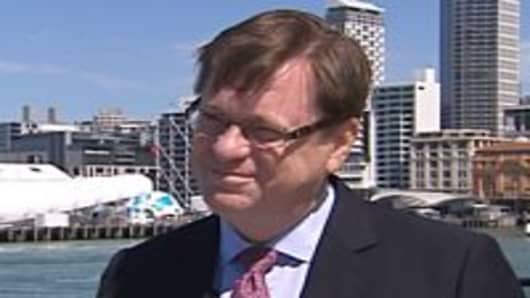ANZ is banking on continued strong growth from Asia despite challenging market conditions. Results released Thursday show Australia's fourth-largest bank posted 4 percent growth in second-half underlying profit, though for the full year ANZ managed earnings of A$5.65 billion ($5.86 billion). CNBC's Christine Tan met up with Alex Thursby, CEO of Asia Pacific, Europe and America, ahead of the earnings report, to find out how the bank is tackling the global headwinds.
Q. Are you worried about a second financial crisis, this time coming from Europe?
I don't think a financial crisis will occur. What I do think will occur in Europe is that they restructure the banking sector, that will take a long time. In fact the economies will not grow. I think we're in for a long term restructuring of the European economy, faced with de-leveraging, faced with recapitalization of the banks and frankly that will dampen demand. So I think the major problem that the world will have with Europe is once it gets through the politics of fixing the problem, there will be a long-term slowdown, maybe five years, maybe even longer. I'm afraid that will have some repercussions around the world.
Q. The last financial crisis saw ANZ snap up Asian assets from RBS. Are you on a lookout for another round of distress sales from European banks?
I think that the little bit of difference this time though is that the assets that will come on sale are not necessarily whole businesses. Part of the fallout that will occur in Europe is that a lot of European banks, in order to be much more capital efficient or to shore up capital, will start to sell down loan assets particularly.
Certain banks have already set internal targets for asset sell-downs. That will be an opportunity, at some point in the next six months, for us to take. But beside that, if business assets come, then we will look at them. But there are always three criteria: they’ve got to be in line with strategy, we’ve got to be able to integrate them, and we’ve got to be able to create medium-term value. If we can’t, then we’re confident enough that our organic strategy is strong and is successful and will continue to be.
Q. You opened your first branch operation in Mumbai in June, years after selling off ANZ’s business in India through your ownership in Grindlays to Standard Chartered. How quickly can you make up for lost ground in that country?
It’s going to take a long time for us to make up but certainly from our first entrée back into the market, we’ve been taken back by our old customers. ANZ is recognized as being an important ingredient of the financial services history in India, and we never really left India. So we’ve gone back in and we’ve got momentum. But it will take us at least five to ten years to really build that business to a substance of Grindlays. The early signs are very, very positive. And we’re very focused on the institutional segment.
Q. You have a 20 percent stake in two Chinese banks Shanghai Rural Commercial Bank and Bank of Tianjin. How quickly do you want to expand into this market?
We actually look at China as Greater China so Taiwan, Hong Kong and clearly the mainland. We are building a business organically. We’re leading with our institutional bank, but we’ve also got a very successful retail business predominantly in Taiwan but moving into the mainland. That will be our primary engine of growth in the long term.
What both Shanghai Rural Commercial and Bank of Tianjin do though is it gives us an opportunity to learn about two of the great five markets of China: the city of Tianjin and the city of Shanghai. We’ve been able to improve the way that they present to the customers, we’ve been able to improve their financial performance. But in the long term, our future sits with the ANZ brand.
Q. So you're totally focused on Asia?
Yes, totally focused on Asia Pacific. And we have one very good business in the Pacific in BNG, which is with the natural resource development that’s going on in that country. It’s prospering very, very well. So those are the major countries that will represent our primary growth in the next five to ten years.
This is an excerpt taken from CNBC’s longest-running feature program Managing Asia. Catch the show with anchor Christine Tan on 4th November 1830 (SIN/HK) and over the weekend on CNBC.


